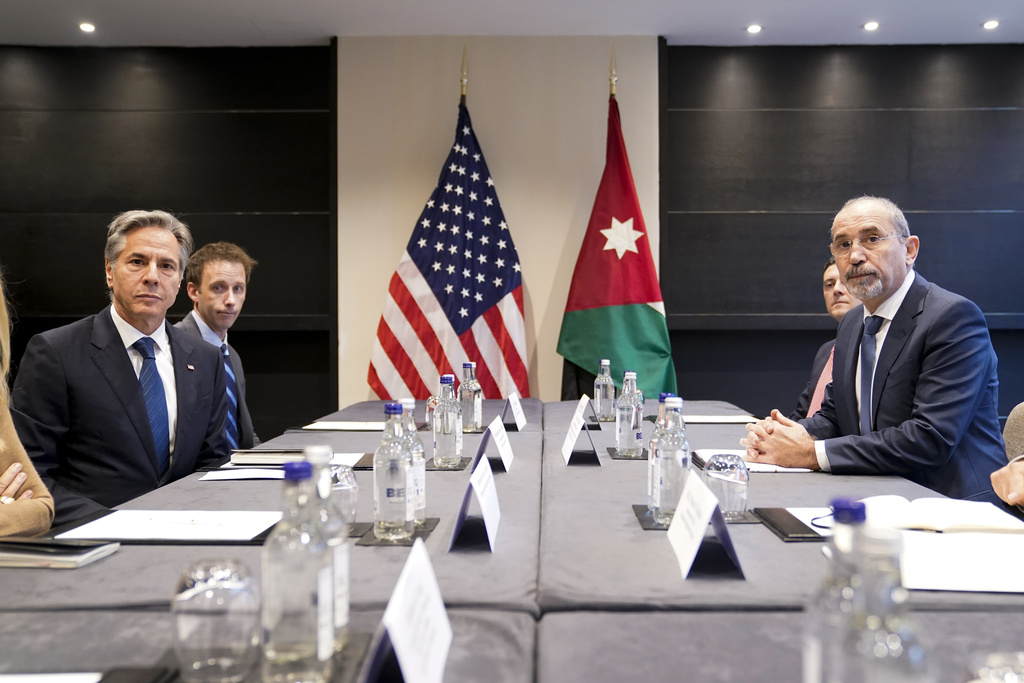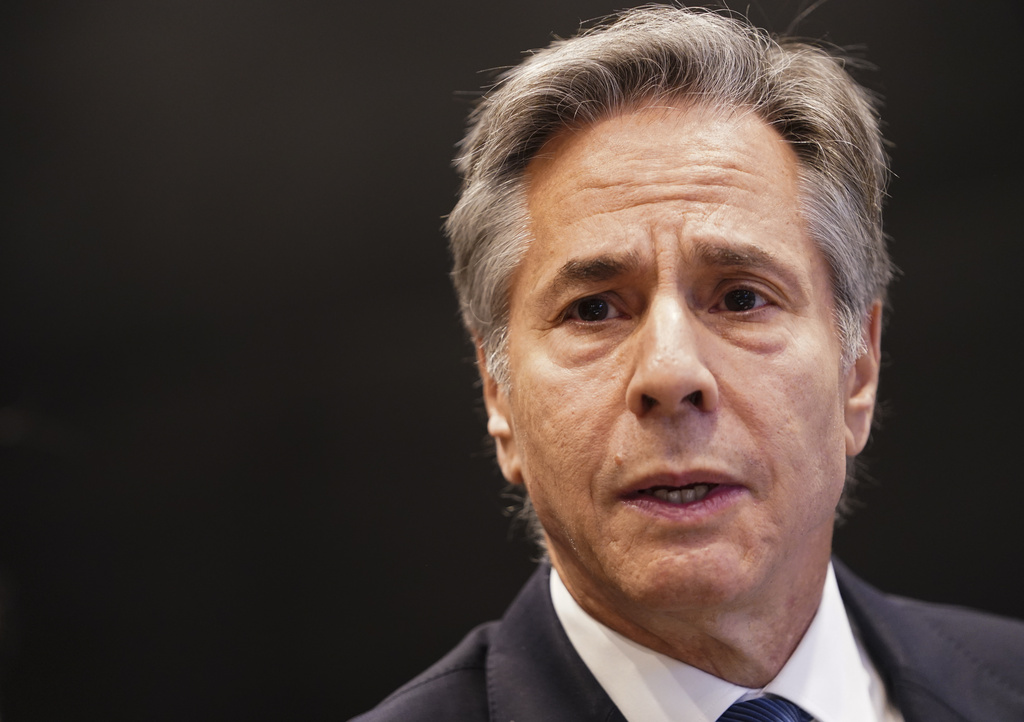Blinken’s Mideast Trip Highlights Gaza Cease-Fire Challenges \ Newslooks \ Washington DC \ Mary Sidiqi \ Evening Edition \ Secretary of State Antony Blinken’s recent Middle East trip aimed at fostering a Gaza cease-fire concluded without a resolution, spotlighting regional unrest. Despite talks on a potential cease-fire, U.S. and Arab leaders saw limited progress. Discussions centered on long-term Palestinian governance and aid delivery to Gaza amid intensifying concerns.

Blinken’s Middle East Trip Quick Looks
- Overview of the Trip: Secretary Blinken’s tour included stops in Israel, Qatar, and Saudi Arabia, with discussions centered on cease-fire proposals, future Palestinian governance, and stabilizing the region.
- Gaza Cease-Fire Efforts: Despite a renewed push for peace talks, differences between Hamas and Israel continued to block progress toward a truce.
- Humanitarian Aid Concerns: The U.S. urged Israel to improve aid access to Gaza, setting a 30-day deadline to enhance support for civilians.
- Hostage Negotiation Talks: Efforts included the potential release of Israeli hostages, with CIA and Mossad heads set to meet in Qatar to further talks.
- Arab Allies’ Frustration: Qatar, Jordan, and other regional leaders publicly criticized the stalled negotiations, stressing the toll on the region.
- U.S. Election Pressure: With U.S. elections looming, the Biden administration faces pressure to show diplomatic progress amid criticism of its Middle East policies.
Deep Look
Secretary of State Antony Blinken’s weeklong diplomatic journey across the Middle East concluded on Friday, with a final stop in London that underscored ongoing challenges in establishing a cease-fire in Gaza. Despite high hopes for a breakthrough, Blinken’s efforts to mediate and address humanitarian concerns over the Gaza-Israel conflict highlighted the steep obstacles that remain. Regional leaders expressed growing frustrations over the protracted violence, referring to the conflicts as a “nightmare” scenario that has brought unprecedented tensions to the area.
Diplomacy Amid Escalation
The Biden administration’s decision to dispatch Blinken to the Middle East came on the heels of Israel’s targeted killing of Hamas military leader Yahya Sinwar, a move seen as opening a narrow diplomatic window for renewed cease-fire discussions. Blinken’s itinerary included stops in Israel, Qatar, and Saudi Arabia, each strategically significant for their roles in regional security and diplomacy. U.S. officials have been particularly focused on seeking an end to the violence that could both secure Israeli interests and ease Palestinian suffering, while also initiating a long-term approach to governance and reconstruction in Gaza.
During the trip, Blinken explored strategies for a Gaza cease-fire, including a potential hostages’ release deal and a blueprint for post-war governance. However, any breakthrough appeared unlikely as the two sides held firmly to their stances. The challenge of finding common ground became even more apparent in Blinken’s last hours in Tel Aviv when air raid sirens sounded, signaling an incoming rocket attack from Lebanon. Israeli defense forces reported intercepting the rockets near Blinken’s location, underscoring the immediacy of the conflict in the lives of those on both sides of the border.
Renewed Talks with Qatar’s Mediation
While a cease-fire remained elusive, Blinken and his team managed to initiate fresh rounds of dialogue. The U.S. and Israel jointly announced that U.S. and Israeli negotiators will soon return to Qatar to engage in indirect talks with Hamas. Blinken, speaking from Doha, emphasized that a key objective will be determining Hamas’s readiness to enter discussions in good faith. Qatar’s role as a mediator is critical, as the Gulf nation has historically bridged gaps between Hamas and Israel in efforts to stabilize the region.
Hamas, however, has shown no signs of softening its stance. Speaking to Lebanese media outlet Al Mayadeen, senior Hamas official Osama Hamdan rejected any shift in Hamas’s position, demanding an end to Israeli hostilities and a full withdrawal from Palestinian territories as preconditions for cease-fire negotiations. Meanwhile, Prime Minister Benjamin Netanyahu’s office announced that Mossad Chief David Barnea will meet with CIA Director Bill Burns and Qatari officials in Qatar on Sunday, with hopes of advancing hostage negotiations.
Blinken’s Emphasis on Humanitarian Concerns
One of the main priorities for the U.S. delegation was addressing the humanitarian crisis in Gaza. Blinken raised U.S. concerns over Israel’s handling of Palestinian aid, with particular attention to a controversial strategy involving the potential forced evacuation of northern Gaza residents. Blinken cautioned Israeli officials about the ramifications of policies that might lead to civilian starvation or loss of life among those unable or unwilling to relocate.
In a private meeting, Blinken pressed Israel to clarify and, if necessary, publicly reject such a plan to mitigate any negative perceptions or fears within the Palestinian territories. Alongside Defense Secretary Lloyd Austin, Blinken had previously sent a stern message to Israeli officials, underscoring the necessity for uninterrupted aid flows to Gaza. Before departing, Blinken issued a 30-day timeline for Israel to begin making measurable improvements in the humanitarian aid process.
The humanitarian situation in Gaza has worsened over the past year, with local authorities reporting over 42,000 Palestinian deaths. Blinken announced $135 million in additional U.S. aid for Palestinians, acknowledging that such support would be meaningless if the assistance could not reach the civilians who need it most. He reiterated the importance of immediate action to alleviate the suffering of Gaza residents.
Arab Allies’ Growing Frustration
Amid diplomatic efforts, Blinken encountered mounting frustrations from key Arab leaders, many of whom voiced disappointment over the lack of progress on a cease-fire. In a notable display of exasperation, Qatar’s Prime Minister Sheikh Tamim bin Hamad Al Thani told reporters that while mediators have come close to brokering peace multiple times, agreements repeatedly unraveled at the final stages. He issued a warning to all parties, suggesting there could be serious consequences for any party unwilling to participate constructively in future negotiations.
Jordanian Foreign Minister Ayman Safadi, in a frank conversation with Blinken in London, expressed his dissatisfaction with Israel’s resistance to international pressure, stating that the “Israeli government is not listening to anyone.” Safadi attributed the ongoing violence to Israeli policies in Gaza, Lebanon, and the West Bank, arguing that such unilateral actions have aggravated regional instability and prolonged suffering. Safadi referred to the situation as a “nightmare” for the entire region, urging the U.S. to press for more decisive action to prevent further escalation.
U.S. Election-Time Pressures and Strategic Goals
Blinken’s visit, occurring just days before the U.S. presidential election, also reflects the political pressures facing the Biden administration to demonstrate effective diplomacy and peace-building in the Middle East. The U.S. government’s approach has faced criticism, particularly from voters who feel that the administration has not adequately constrained Israel’s military actions in Gaza. Vice President Kamala Harris has been a particular target of criticism for what some view as her lukewarm response to Israel’s conduct.
Despite the heightened focus on domestic concerns, the administration remains invested in seeking a solution in Gaza that could help bolster its international standing. Blinken and his team see the current diplomatic environment as a narrow window to reignite peace negotiations, with Sinwar’s recent killing adding urgency to the talks. The Biden administration also hopes that a well-formulated post-war plan could address some of the grievances in Gaza by supporting Palestinian governance, rebuilding Gaza’s infrastructure, and establishing a stable framework for security and economic growth.
As the visit concluded, the Biden administration remains hopeful that renewed discussions in Qatar, facilitated by allies and intelligence leaders, could set the stage for incremental progress toward a cease-fire and possibly a sustainable path forward for the people of Gaza.
Blinken’s Mideast Blinken’s Mideast Blinken’s Mideast Blinken’s Mideast








You must Register or Login to post a comment.